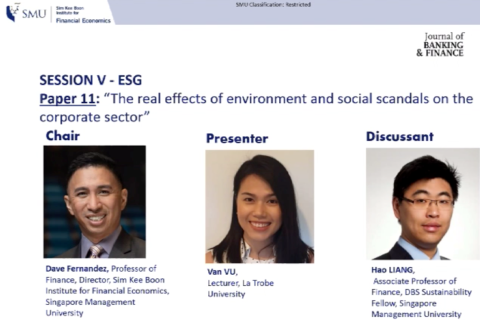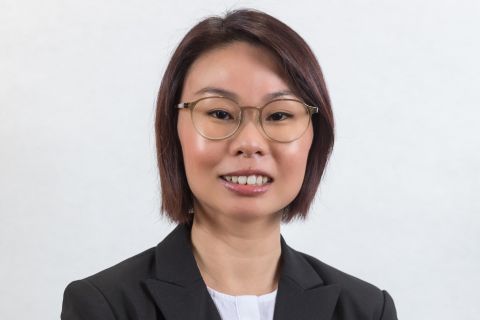Above: Ms Anna Joubin-Bret, Secretary of the United Nations Commission on International Trade Law (UNCITRAL) and Director of the Division on International Trade Law in the Office of Legal Affairs of the United Nations.
Middle (left-right): Mr Zannis Mavrogordato, a Barrister at law firm Twenty Essex; Professor Nadja Alexander, Director of Singapore International Dispute Resolution Academy (SIDRA); Associate Professor Darius Chan, Deputy Director of SIDRA.
Below (left-right): Ms Frauke Nitschke, Senior Counsel at the International Centre for Settlement of Investment Disputes (ICSID); Ms Lucy Reed, President of the International Council for Commercial Arbitration (ICCA) and Vice President of the Singapore International Arbitration Centre Court (SIAC).
By Rebecca Tan
SMU Office of Research & Tech Transfer – Money may make the world go round, but attracting that money into one particular country over another can be challenging. One way that governments around the world have tried to increase the amount of foreign direct investment they receive is through negotiating free trade agreements, many of which typically include provisions for resolving disputes, should they arise.
Called investor-state dispute settlement (ISDS), these extra-judicial methods allow foreign investors to seek compensation from countries if certain investment obligations are breached. For example, Canadian mining company Rusoro was able to use the ISDS mechanism to claim nearly US$1 billion from the government of Venezuela when their gold mines were expropriated by a nationalisation decree.
However, ISDS is not without its critics. Opponents say that ISDS can be used against governments trying to act in the best interests of their people, as was the case when tobacco manufacturer Philip Morris attempted to claim damages from Australia for introducing plain packaging laws in 2012. Although the arbitration process eventually ruled in Australia’s favour, the legal battle dragged on to 2015, costing the government A$24 million (~US$17 million) in the process.
There is, however, a potentially better way to resolve investor-state disputes, one that promises to be faster, cost less and preserve the long-term relationship between the investor and the state: mediation. In a 2020 survey by the Singapore International Dispute Resolution Academy (SIDRA), legal and client users expressed an openness to selecting methods such as mediation to resolve their disputes, despite the current dominance of arbitration in ISDS. To further discuss the role that mediation can play in ISDS, the Singapore International Dispute Resolution Academy (SIDRA) at the Singapore Management University organised a special commemorative webinar on 12 September 2020, the day the Singapore Convention on Mediation officially came into force. The panel was moderated by Professor Nadja Alexander, Director of SIDRA, and Associate Professor Darius Chan, Deputy Director of SIDRA.
From Singapore, to the world
Already signed by 53 countries and ratified by six states, the Singapore Convention enables the enforcement of international mediated settlement agreements (iMSAs) arrived at by mediation. This ability to enforce iMSAs is likely to make mediation an attractive option, particularly since 90 percent of all bilateral investment treaties include a ‘cooling-off’ period during which arbitration proceedings are required to be put on hold while both parties explore amicable resolutions, including mediation.
“The big question is to understand how this can be done,” said Ms Anna Joubin-Bret, Secretary of the United Nations Commission on International Trade Law (UNCITRAL) and Director of the Division on International Trade Law in the Office of Legal Affairs of the United Nations. “This topic is worth exploring in light of the effectiveness of mediation and the cost savings that can result. The flexibility, autonomy and preservation of the long-term relationship between the investor and the state also form part of the appeal to continue down this path,” Ms Joubin-Bret said.
Given that 82 percent of corporate lawyers surveyed in 2014 said that an instrument for enforcing iMSAs would increase their willingness to engage in mediation, mediation is now likely to be seen as an increasingly viable alternative to arbitration, said Ms Frauke Nitschke, Senior Counsel at the International Centre for Settlement of Investment Disputes (ICSID). “The Singapore Convention, and the work the states have put into it, have created a ‘halo effect’ that has already impacted the consideration of mediation as a possibility. Within the investor-state context, having an international multilateral treaty like the Singapore Convention ratified so quickly speaks for itself,” Ms Nitschke said.
Mind the gap
While mediating disputes sounds good on paper, there are many challenges in practice, particularly when it comes to investor-state relations, said Mr Zannis Mavrogordato, a Barrister who specialises in international commercial and investment arbitration at law firm Twenty Essex. “Where governments are concerned, there can be systemic problems resulting from a lack of coordination between different ministries and decision makers. But the fact that there are obstacles and the fact that it won’t always be possible to settle aren’t reasons to give up on the prospect of settlement during a cooling off period,” he said.
Instead, awareness of mediation as an option can be built by offering training while at the same time creating the relevant infrastructure to enable mediations to take place effectively, Mr Mavrogordato said. For example, a database of investors and state mediators who are familiar with the types of obstacles faced during investor-state disputes could be helpful, he suggested.
“That said, I don’t personally think that mediation alone can plug the gap left by the absence of processes about the amicable negotiation exercise. As mediation is voluntary, there will inevitably be instances in which the parties are reluctant to agree, or won’t be able to agree within the short duration of the cooling off period,” Mr Mavrogordato said.
Furthermore, it is possible that parties might use mediation as a stalling technique to postpone the inevitable, raising the suspicion that mediation will double the cost and time if the dispute ends up being one that needs to be arbitrated or litigated, added Ms Lucy Reed, President of the International Council for Commercial Arbitration (ICCA) and Vice President of the Singapore International Arbitration Centre Court (SIAC).
To prevent this from happening, Ms Reed suggested a hybrid approach involving a mediator working in parallel with arbitrators or using ‘evaluative mediation’, where an expert mediator first makes an assessment on whether one party or the other has a good chance of winning the eventual arbitration.
“In my career of largely investor-state disputes and complex commercial disputes involving states, I think at least 40 percent of them could and should have been settled with the assistance of a skilled mediator. I like to win those cases in arbitration, but it’s such a waste of resources,” Ms Reed said. “So when young practitioners ask me what they can do to get into an international field, I urge them to think about international mediation, a new and important area that requires study and training.”
Back to Research@SMU Nov 2020 Issue
See More News
Want to see more of SMU Research?
Sign up for Research@SMU e-newslettter to know more about our research and research-related events!
If you would like to remove yourself from all our mailing list, please visit https://eservices.smu.edu.sg/internet/DNC/Default.aspx

